Removal of Carmine from Aqueous Solution by Carbonated Hydroxyapatite Nanorods
Abstract
:1. Introduction
2. Materials and Methods
2.1. Materials
2.2. Samples Synthesis
2.3. Characterization Methods
2.4. Carmine Adsorption Experiments
3. Results and Discussion
3.1. Structural and Morphological Characteristics
3.2. Carmine Adsorption Kinetics
3.2.1. Adsorption Kinetics
3.2.2. Adsorption Isotherms
4. Conclusions
Acknowledgments
Author Contributions
Conflicts of Interest
References
- Yagub, M.T.; Sen, T.K.; Afroze, S.; Ang, H.M. Dye and its removal from aqueous solution by adsorption: A review. Adv. Colloid Interface Sci. 2014, 209, 172–184. [Google Scholar] [CrossRef] [PubMed]
- Lian, L.L.; Guo, L.P.; Guo, C.J. Adsorption of Congo red from aqueous solutions onto Ca-bentonite. J. Hazard. Mater. 2009, 161, 126–131. [Google Scholar] [CrossRef] [PubMed]
- Hokkanen, S.; Bhatnagar, A.; Repo, E.; Lou, S.; Sillanpää, M. Calcium hydroxyapatite microfibrillated cellulose composite as a potential adsorbent for the removal of Cr(VI) from aqueous solution. Chem. Eng. J. 2016, 283, 445–452. [Google Scholar] [CrossRef]
- Zhang, F.; Zhao, Z.S.; Tan, R.Q.; Xu, W.; Jiang, G.B.; Song, W.J. Efficient and selective immobilization of Pb2+ in highly acidic wastewater using strontium hydroxyapatite nanorods. Chem. Eng. J. 2012, 203, 110–114. [Google Scholar] [CrossRef]
- Yang, H.H.; Liu, Q.; Masse, S.; Zhang, H.; Li, L.F.; Coradin, T. Hierarchically-organized, well-dispersed hydroxyapatite-coated magnetic carbon with combined organics and inorganics removal properties. Chem. Eng. J. 2015, 275, 152–159. [Google Scholar] [CrossRef]
- Hokkanen, S.; Repo, E.; Westholm, L.J.; Lou, S.; Sainio, T.; Sillanpää, M. Adsorption of Ni2+, Cd2+, PO43− and NO3− aqueous solutions by nanostructured microfibrillated cellulose modified with carbonated hydroxyapatite. Chem. Eng. J. 2014, 252, 64–74. [Google Scholar] [CrossRef]
- Dorozhkin, S.V. Nanosized and nanocrystalline calcium orthophosphates. Acta Biomater. 2010, 6, 715–734. [Google Scholar] [CrossRef] [PubMed]
- Farzadi, A.; Bakhshi, F.; Solati-Hashjin, M.; Asadi-Eydivand, M.; Osman, N.A.A. Magnesium incorporated hydroxyapatite: Synthesis and structural properties characterization. Ceram. Int. 2014, 40, 6021–6029. [Google Scholar] [CrossRef]
- Gao, X.; Song, J.L.; Ji, P.; Zhang, X.H. Polydopamine-templated hydroxyapatite reinforce polycaprolactone composite nanofibers with enhanced cytocompatibility and osteogenesis for bone tissue engineering. ACS Appl. Mater. Interfaces 2016, 8, 3499–3515. [Google Scholar] [CrossRef] [PubMed]
- Wang, X.; Hu, P.; Fangli, Y.; Yu, L. Preparation and characterization of ZnO hollow spheres and ZnO-Carbon composite materials using colloidal carbon spheres as templates. J. Phys. Chem. C 2007, 111, 6706–6712. [Google Scholar] [CrossRef]
- Yang, Z.; Huang, Y.; Chen, S.T.; Zhao, Y.Q.; Li, H.L.; Hu, Z.A. Template synthesis of highly ordered hydroxyapatite nanowire arrays. J. Mater. Sci. 2015, 40, 1121–1125. [Google Scholar] [CrossRef]
- Jeon, S.H.; Xu, P.; Zhang, B.; Mack, N.H.; Tsai, H.; Chiang, L.Y.; Wang, H.L. Polymer-assisted preparation of metal nanoparticles with controlled size and morphology. J. Mater. Chem. 2011, 21, 2550–2554. [Google Scholar] [CrossRef]
- Tseng, Y.H.; Kuo, C.S.; Li, Y.Y.; Huang, C.P. Polymer-assisted synthesis of hydroxyapatite nanoparticle. Mater. Sci. Eng. C 2009, 29, 819–822. [Google Scholar] [CrossRef]
- Xie, R.Q.; Feng, Z.D.; Li, S.W.; Xu, B.B. EDTA-assisted self-assembly of fluoride-substituted hydroxyapatite coating on enamel substrate. Cryst. Growth Des. 2011, 11, 5206–5214. [Google Scholar] [CrossRef]
- Zandi, M.; Mirzadeh, H.; Mayer, C.; Urch, H.; Eslaminejad, M.B.; Bagheri, F.; Mivehchi, H. Biocompatibility evaluation of nano-rod hydroxyapatite/gelatin coated with nano-HAp as a novel scaffold using mesenchymal stem cells. J. Biomed. Mater. Res. A 2010, 92, 1244–1255. [Google Scholar] [CrossRef] [PubMed]
- Qi, C.; Zhu, Y.J.; Zhao, X.Y.; Zhao, J.; Chen, F.; Cheng, G.F.; Ruan, Y.J. High surface area carbonate apatite nanorod bundles: Surfactant-free sonochemical synthesis and drug loading and release properties. Mater. Res. Bull. 2013, 48, 1536–1540. [Google Scholar] [CrossRef]
- Wang, Y.J.; Chen, J.D.; Wei, K.; Zhang, S.H.; Wang, X.D. Surfactant-assisted synthesis of hydroxyapatite particles. Mater. Lett. 2006, 60, 3227–3231. [Google Scholar] [CrossRef]
- Zhang, Y.; Liu, Y.; Ji, X.B.; Banksb, C.E.; Song, J.F. Flower-like agglomerates of hydroxyapatite crystals formed on an egg-shell membrane. Colloid Surf. B 2011, 82, 490–496. [Google Scholar] [CrossRef] [PubMed]
- Liu, J.B.; Li, K.W.; Wang, H.; Zhu, M.K.; Xu, H.Y.; Yan, H. Self-assembly of hydroxyapatite nanostructures by microwave irradiation. Nanotechnology 2005, 16, 82–87. [Google Scholar] [CrossRef]
- Deng, Y.; Sun, Y.H.; Chen, X.F.; Zhu, P.Z.; Wei, S.C. Biomimetic synthesis and biocompatibility evaluation of carbonated apatites template-mediated by heparin. Mater Sci. Eng. C 2013, 33, 2905–2913. [Google Scholar] [CrossRef] [PubMed]
- Liao, J.G.; Li, Y.Q.; Duan, X.Z. Synthesis and Characterization of CO32− doping nano-hydroxyapatite. Spectrosc. Spect. Anal. 2014, 34, 3011–3014. [Google Scholar]
- Antonakos, A.; Liarokapis, E.; Leventouri, T. Micro-Raman and FTIR studies of synthetic and natural apatites. Biomaterials 2007, 28, 3043–3054. [Google Scholar] [CrossRef] [PubMed]
- Penel, G.; Leroy, G.; Rey, C.; Bres, E. Micro Raman spectral study of the PO43− and CO32− vibrational modes in synthetic and biological apatites. Calcif. Tissue Int. 1998, 63, 475–481. [Google Scholar] [CrossRef] [PubMed]
- Awonusi, A.; Morris, M.D.; Tecklenburg, M.M.J. Carbonate assignment and calibration in the raman spectrum of apatite. Calcif. Tissue Int. 2007, 81, 46–52. [Google Scholar] [CrossRef] [PubMed]
- Repo, E.; Warchol, J.K.; Kurniawan, T.A.; Sillanpaa, M.E. Adsorption of Co(II) and Ni(II) by EDTA- and/or DTPA-modified chitosan: Kinetic and equilibrium modeling. Chem. Eng. J. 2010, 161, 73–82. [Google Scholar] [CrossRef]
- Lafon, J.P.; Champion, E.; Bernache-Assollant, D. Processing of AB-type carbonated hydroxyapatite Ca10−x(PO4)6−x(CO3)x(OH)2−x−2y(CO3)y ceramics with controlled composition. J. Eur. Cream. Soc. 2008, 28, 139–147. [Google Scholar] [CrossRef]
- Rengaraj, S.; Yeon, K.H.; Moon, S.H. Removal of chromium from water and wastewater by ion exchange resins. J. Hazard. Mater. 2001, 87, 273–287. [Google Scholar] [CrossRef]
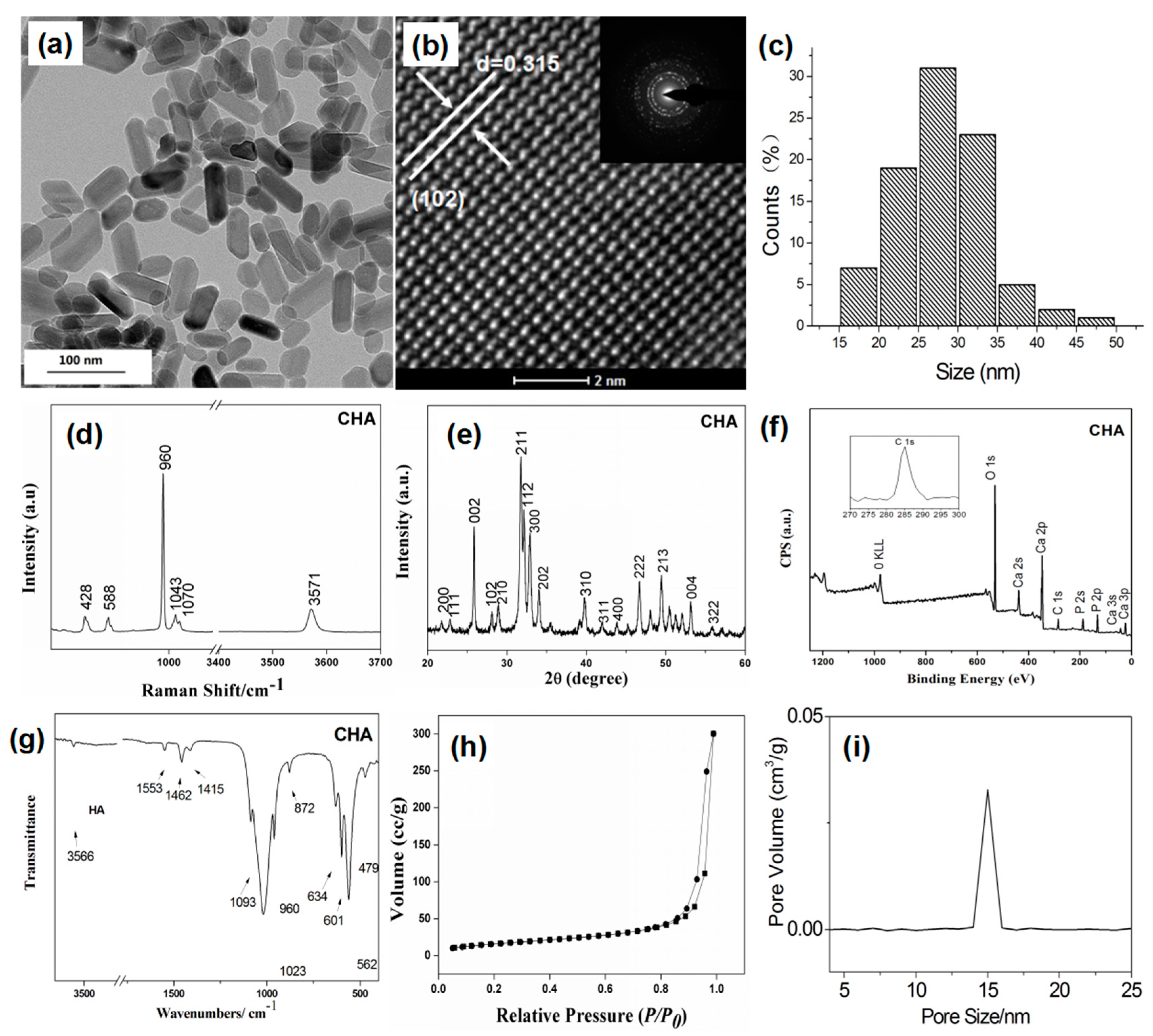

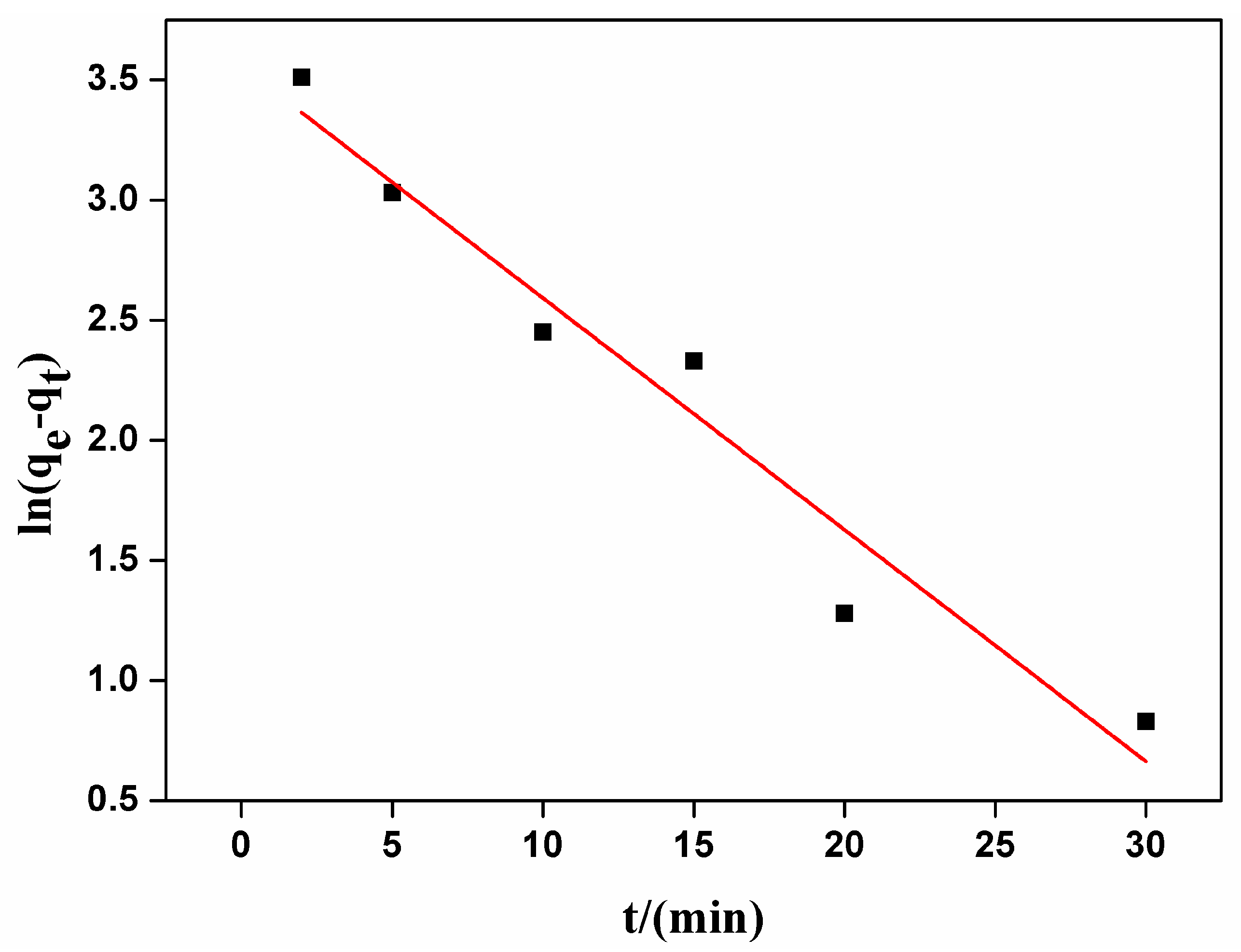
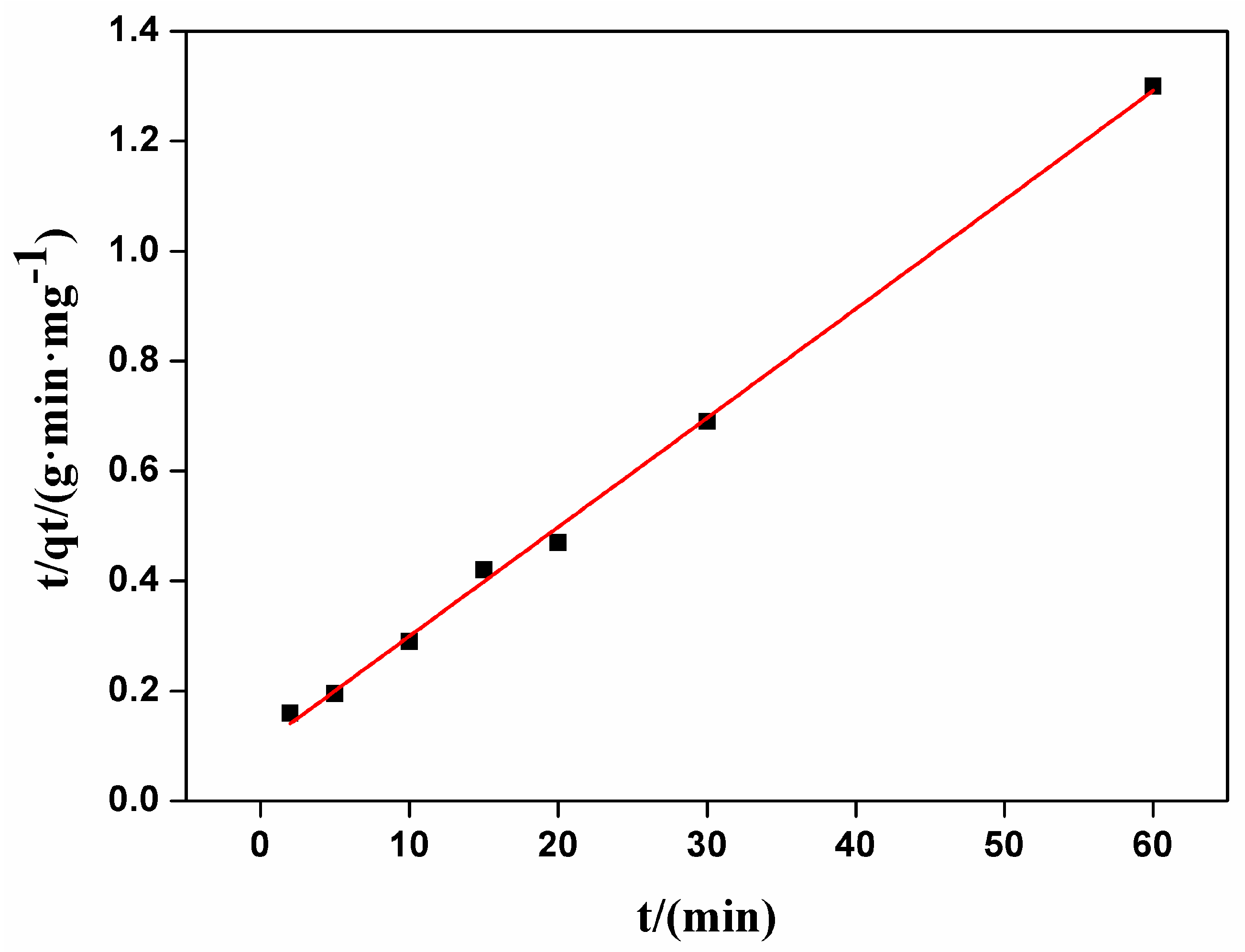

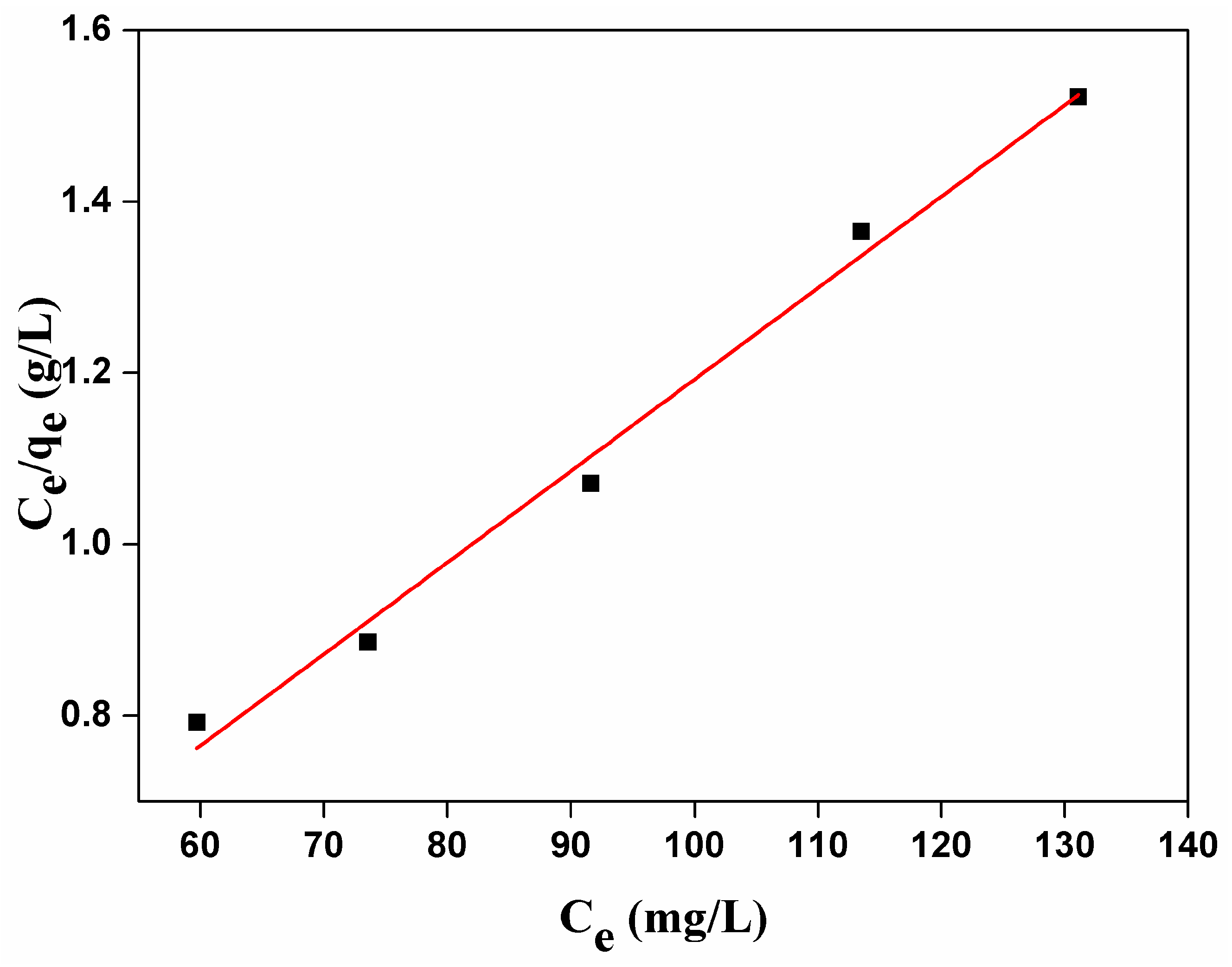
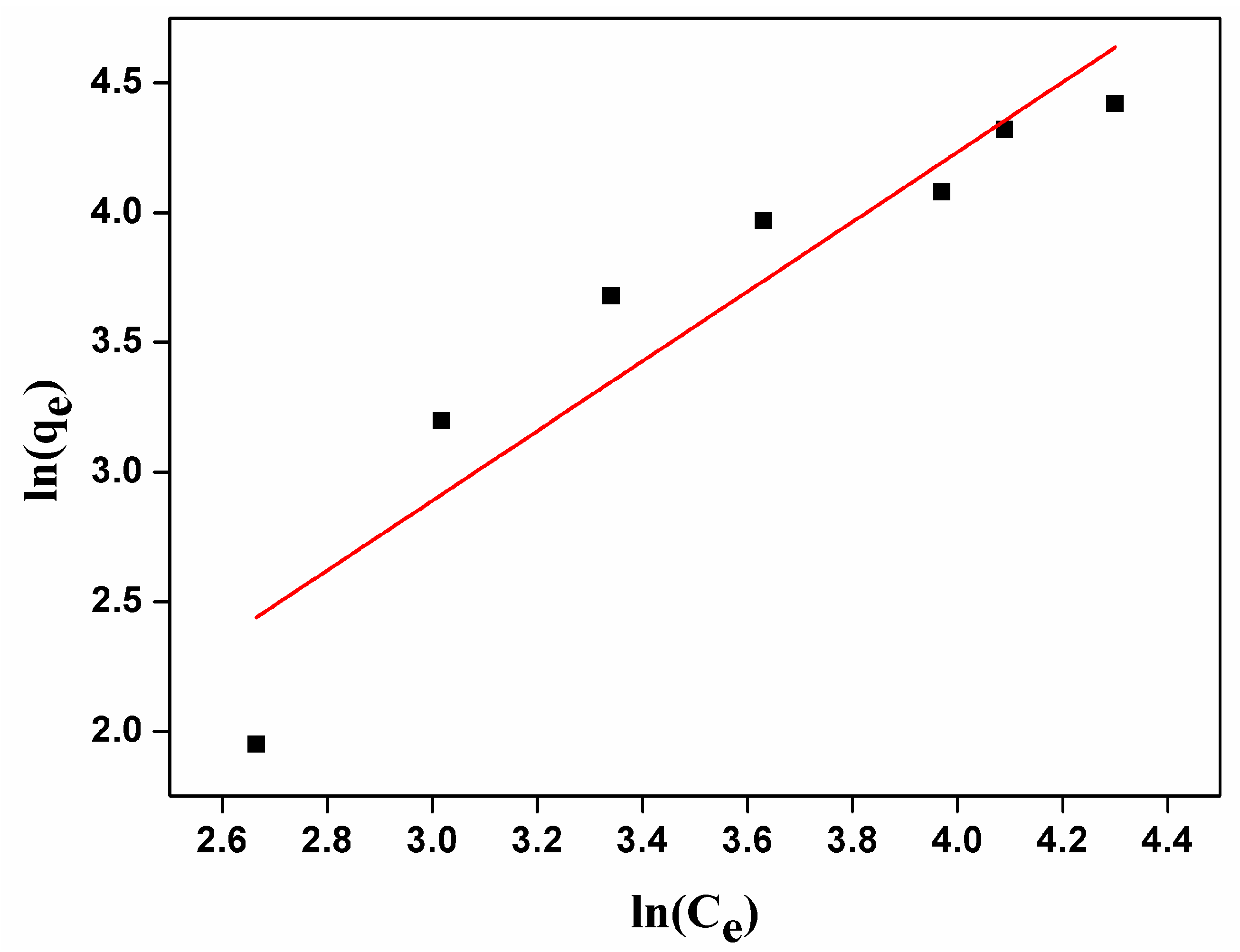
| Sample Name | SBET (m2/g) | VP (cm3/g) | Pore Size (nm) |
|---|---|---|---|
| CHA | 61.88 | 0.462 | 14.92 |
| Kinetics Models | qe,exp (mg/g) | qe,cal (mg/g) | k1 (min−1) | k2 (mg/(g min)) | R2 |
|---|---|---|---|---|---|
| Pseudo-first-order model | 46.57 | 35.02 | 0.095 | - | 0.9421 |
| Pseudo-second-order model | 50.40 | - | 0.00389 | 0.9977 |
| θ (K) | Langmuir | Freundlich | ||||
|---|---|---|---|---|---|---|
| qm (mg/g) | Ke | R2 | n | Kf | R2 | |
| 298 | 93.63 | 0.0858 | 0.9887 | 0.7439 | 0.319 | 0.8517 |
© 2017 by the authors. Licensee MDPI, Basel, Switzerland. This article is an open access article distributed under the terms and conditions of the Creative Commons Attribution (CC BY) license (http://creativecommons.org/licenses/by/4.0/).
Share and Cite
Liu, G.; Xue, C.; Zhu, P. Removal of Carmine from Aqueous Solution by Carbonated Hydroxyapatite Nanorods. Nanomaterials 2017, 7, 137. https://doi.org/10.3390/nano7060137
Liu G, Xue C, Zhu P. Removal of Carmine from Aqueous Solution by Carbonated Hydroxyapatite Nanorods. Nanomaterials. 2017; 7(6):137. https://doi.org/10.3390/nano7060137
Chicago/Turabian StyleLiu, Guanxiong, Caibao Xue, and Peizhi Zhu. 2017. "Removal of Carmine from Aqueous Solution by Carbonated Hydroxyapatite Nanorods" Nanomaterials 7, no. 6: 137. https://doi.org/10.3390/nano7060137





